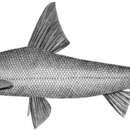Diagnostic Description
provided by Fishbase
Diagnosed from other species of Barbus and Luciobarbus in Caspian Se basin by having the following characters: predorsal length shorter than postdorsal length; dorsal fin usually with 7½ branched rays; 16-25 gill rakers; back between head and dorsal origin laterally compressed, forming a keel; lateral line with 62-90 (usually 65-77) scales; and lower lip thin, without median lobe or pad (Ref. 59043).
Life Cycle
provided by Fishbase
Eggs are semipelagic and hatch while drifting downstream after at least 2 days at 25°C. Larvae settle into places with slow current; after 2-12 months juveniles drift downstream to sea or reservoir if river is dammed (Ref. 59043).
- Recorder
- Anita Wiethüchter
Migration
provided by Fishbase
Potamodromous. Migrating within streams, migratory in rivers, e.g. Saliminus, Moxostoma, Labeo. Migrations should be cyclical and predictable and cover more than 100 km.
Trophic Strategy
provided by Fishbase
Feeds primarily on insects and plants (Ref. 9037). Does not feed while migrating upstream. At spawning sites, starts to feed again, mainly on insects, juveniles of other fishes, rarely on algae, seeds and other plant material (Ref. 59043).
Biology
provided by Fishbase
Found in rivers, reservoirs, lakes and canals (Ref. 11145). Occurs in the sea at depths of up to 25 m and in rivers in deep stretches with gravel or stone bottom. In freshened parts of sea, preys mainly on benthic crustaceans. Does not feed while migrating upstream and starts to feed again at the spawning sites mainly on insects, juveniles of other fishes, rarely on algae, seeds and other plant material. Spawns in fast-flowing water at areas with hard bottom and depths of 1-2 m (Ref. 59043).
Importance
provided by Fishbase
fisheries: commercial
Aral barbel
provided by wikipedia EN
The Aral barbel (Luciobarbus brachycephalus) is a species of ray-finned fish in the genus Luciobarbus. It is found in the Aral basin, Chu drainage and southern and western Caspian Sea. For spawning, it migrates up to larger tributaries of the western and southern coasts.
References

- license
- cc-by-sa-3.0
- copyright
- Wikipedia authors and editors
Aral barbel: Brief Summary
provided by wikipedia EN
The Aral barbel (Luciobarbus brachycephalus) is a species of ray-finned fish in the genus Luciobarbus. It is found in the Aral basin, Chu drainage and southern and western Caspian Sea. For spawning, it migrates up to larger tributaries of the western and southern coasts.
- license
- cc-by-sa-3.0
- copyright
- Wikipedia authors and editors

